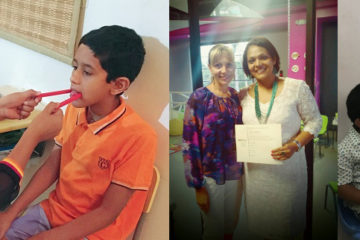Oral Placement Therapy was developed by Sara Rosenfeld Johnson (Founder of TalkTools®). After using this particular technique along with traditional speech therapy techniques for the past 5 years, we at PlayStreet have found it to be quite effective in helping children move from being non-verbal to making a few sounds and so forth. We have also found this technique to be most useful when helping children with feeding difficulties or food sensitivities. We have seen fantastic results when working with children with Autism, Apraxia, Cerebral Palsy, Downs Syndrome, Developmental Delays and other related Childhood Language Disorders.
Playstreet provides oral placement therapy. For details see here
Watch Sara's video to know a little bit more about OPT
Sara Rosenfeld Johnson, in her book 'Oral Placement Therapy for Speech Clarity and Feeding' says that:
"Speech is the end result of 4 critical elements of muscle movement:
1. Awareness of the oral structures
2. Placement of the oral structures
3. Stability, endurance and muscle memory
4. Production"
Awareness is the sensory component of movement. If a client is unable to "feel" the position of a muscle or has a negative reaction to this 'feel', speech clarity and feeding abilities will be compromised. A client could be hypersensitive or tactile defensive, hyposensitive to tactile input, or have mixed or fluctuating responsivity to tactile input. These reactions could be seen any client with a variety of diagnoses - Autism, ADHD, Apraxia, Cerebral Palsy, Downs Syndrome, Visual Impairments, etc. Therapists and Parents need to be aware of these reactions to ultimately facilitate the development of Speech or better Feeding abilities. We have noticed a lot of difference in children once they actually became aware of their oral structures through the structured OPT program we followed. Children who were non-verbal started making sounds and babbling. Children who were drooling started swallowing more. Children who wouldn't move their tongue or lips started doing so. Children who were sensitive to food gradually started eating better.
"Oral Placement Therapy or OPT therapy for speech teaches oral structural placement to clients who cannot produce or imitate speech sounds using traditional auditory or visual input...... it is a tactile-proprioceptive teaching technique which accompanies traditional therapy"
When we talk about Placement of Oral Structures with reference to speech and feeding skills, we help children to learn where to place their articulators with the help of therapy tools. However unlike other traditional methods of "Look at me and say what I say", OPT looks at adding the tactile stimuli to teach placement of the oral structures. Especially for children with Childhood Apraxia of Speech or Dyspraxia, tactile cues are the key to improved speech clarity and feeding skills. OPT uses a variety of 'Therapy Tools' like Horns, Bubbles, Straws, Jaw Grading Bite Blocks, Chewy Tubes, ARK Grabbers, etc. in a hierarchical and structured manner to help children improve skill levels by maximising all the sensory systems.
You can get more information about these tools on www.talktools.com or www.helpthemshine.com.
Once a client (child or adult) becomes more aware of his oral structures and then has learnt where to place his jaws, lips and tongue for various sounds or for appropriate feeding skills, OPT works on building the clients Stability, Endurance and Muscle Memory. This just means that the muscles are taught movements through increased repetitions so that the movements become automatic and are not lost. Neural connections can be developed every day and the more neural connections there are, the higher chances of speech developing as a way of communicating. If the foundation for the development of speech is poor, it is unfair for us to expect the child to just start 'talking'. Hence OPT takes the client through a hierarchical and structured program or steps to reach the 'Criteria of Success' at each step. The number of repetitions is based upon stability, endurance, adequate strength and muscle memory requirements and must be followed closely if success is expected.
One example of building stability, endurance and muscle memory via the Horn Hierarchy is to have the client blow the Horn 25 times in rapid succession. This helps the client become aware of his structures, learn how to purse his lips for blowing and strengthen his lips to endure that movement 25 times. It also teaches the muscles the automaticity in the movement (muscle memory) so that the client purses or rounds his lips the minute he/she sees the Horn. This is the basis for a sound like /oo/.
'Talking' or production of speech sounds is not as easy as one thinks it out to be. There are a lot of brain processes involved to coordinate between getting the idea about what to say to planning the movements necessary for it to actually saying it. If we talk about the production of speech alone, we have seen that an individual needs to be AWARE of his oral structures, know the PLACEMENT of his oral structures, have enough STRENGTH, STABILITY, ENDURANCE & MUSCLE MEMORY to finally be able to PRODUCE speech sounds or produce the movements needed for appropriate feeding skills. To develop a foundation for good speech skills, it is important that the clients JAW is strong, stable and graded. It is the jaw that forms the foundation for developing movements of the lips and the tongue. An example of how we would develop the strength and graded movement of the jaw would be by using therapy tools such as the Chewy Tubes, Jaw Grading Bite Blocks, etc.
To know more, watch the video below...
Reference:
Sara Rosenfeld-Johnson (2001). Oral Placement Therapy for Speech Clarity and Feeding. Fourth Edition



0 Comments